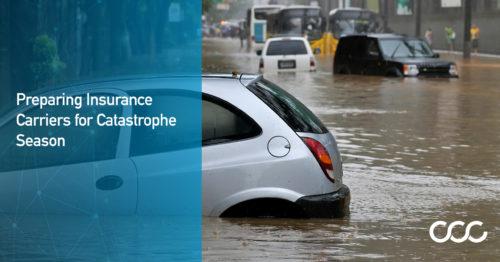
To account for reduced driving because of social distancing and shelter-at-home guidelines, auto insurers are returning around $10.5 billion to their customers, providing financial relief when they need it most. But on top of the premium rebates being offered to drivers, a major natural disaster could be catastrophic for business.
As we enter peak catastrophe “CAT” season amid a global pandemic, what impact could a natural disaster have on insurance carriers and their policyholders? And how can they prepare for what’s to come?
2020 EXTREME WEATHER FORECAST
Extreme weather has been on the rise for the last 40 years, with billion-dollar weather and climate disasters increasing in both frequency and severity. In April 2020 alone, tornadoes and hail damage cost insurance carriers billions of dollars.
These events can lead to significant fluctuations in vehicle age of comprehensive losses and the share of which are repairable versus total loss claims. By introducing this level of volatility into the claims process, severe weather can have a big impact on cost and customer satisfaction.
Here’s what we can expect from the upcoming CAT season:
Hurricanes
Hurricane season has officially started, and early predictions indicate it could be one of the toughest yet.
While total losses typically trend toward older vehicles, hurricanes tend to impact a greater share of newer vehicles versus day-to-day total loss claims. It’s not that newer vehicles are more susceptible to destruction but rather that hurricanes are great equalizers, damaging a greater mix of newer, more expensive cars. Average vehicle age is also lower in coastal states where hurricanes are more likely to strike, further increasing the likelihood of damage to younger vehicles.
For example, in Q4’16-Q3’17, Hurricane Harvey struck Texas and flooded large volumes of vehicles. As a result, the age of comprehensive losses was younger than in other periods and total loss costs were higher.
Younger vehicles mean higher loan payoffs. And because newer vehicles often have outstanding loan balances, consumers get less of the payoff.
Flooding
Water-heavy incidents, such as flooding and slow-moving, rain-heavy hurricanes, have an impact on total losses. It doesn’t take much if the water reaches the floorboards — especially brackish water — for the vehicle to become a total loss.
Flash flooding is most common in late spring into summer, with 75 percent of all reports occurring from late April through mid-September. Widespread flooding is expected this year, though it’s not predicted to reach the severity of 2019.
Hail
States that are more likely to see hail also tend to see repair volumes spike from a single large event. These spikes can often result in significant swings in volume share of comprehensive losses related to hail. Similar volatility in claim count and makeup is expected as storm severity continues to grow in the coming years.
Tornadoes
Tornado season is in full spin following the most active April since 2012, which could be a sign of a difficult season to come. And though tornadoes are unpredictable, insurance carriers should be prepared for them in addition to other thunderstorm events.
Weathering the Storm Ahead
After a severe weather event, consumers will likely be dealing with issues beyond auto claims — house damage, injuries, etc. They may need to coordinate with emergency services and other insurance carriers. And since these types of events impact communities as opposed to just individuals, friends, family and neighbors could also need help, compounding needs and stress.
At a time when people are already experiencing economic hardships, losing a car could be devastating. Streamlining the process of getting policyholders back on the road becomes even more important than under “normal” circumstances.
Insurance carriers relying on manual, non-digital processes may have trouble underwriting risk, covering losses, and reducing business interruption when extreme weather occurs. Layer on limitations presented by social distancing — preventing adjusters from being on site to write in-person estimates and offer a comforting presence — and it will be even more difficult to deliver a positive user journey.
Leveraging technology and workflow improvements may help simplify these processes, increasing customer satisfaction while keeping employees safe and reducing costs.
Digital Total Loss Experience
CCC® Resolve is a self-service app designed specifically for auto damage caused by weather-related catastrophes. By guiding policyholders through a series of photos and key CAT-related questions, CCC Resolve helps them quickly capture vehicle condition to initiate and streamline the claims process.
For vehicles declared a total loss, CCC® Total Loss Care connects participating carriers and automotive lenders in one place to expedite resolution. Data from CCC suggests that through the combination of its tools, cycle time can be reduced to days instead of weeks, which can be typical with offline total loss claims management.
So, while natural disasters can be difficult to predict, these innovations could help insurers brace for the worst while better preparing for the volatility that comes with severe weather.
To learn more about CCC Resolve or schedule a demo, please contact solutions@cccis.com. Or explore CCC’s other digital claims solutions to learn more about Total Loss Care and other innovative tools.


